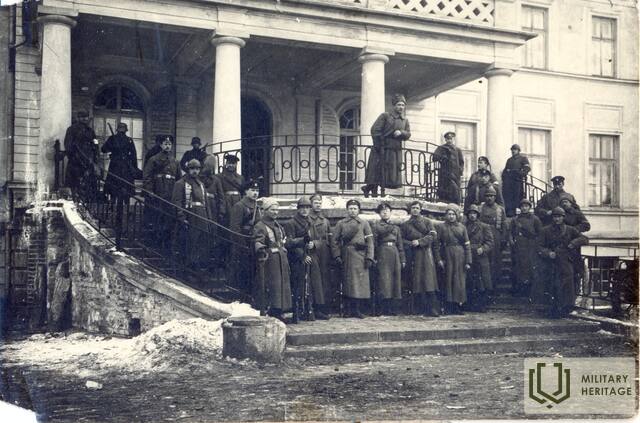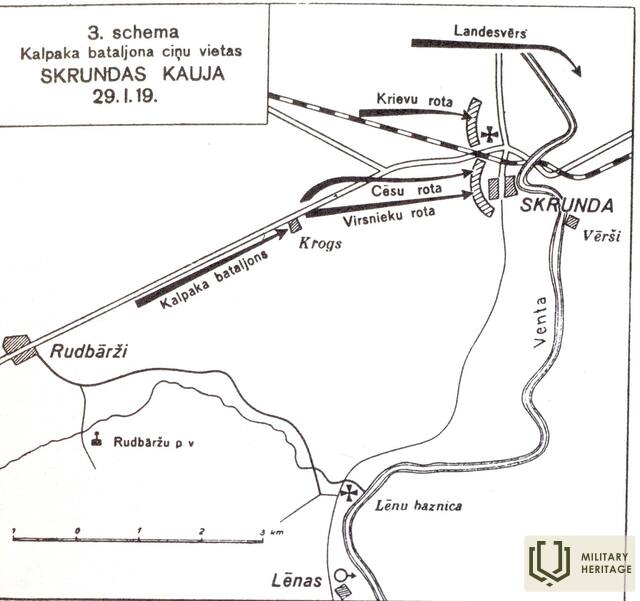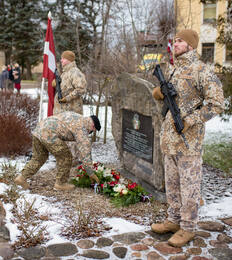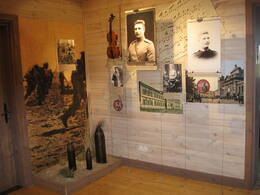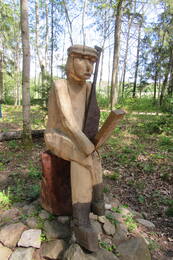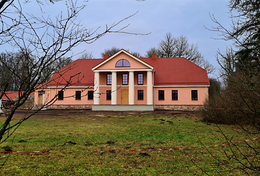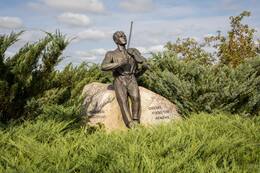Pulkininko Oskaro Kalpako didvyriškumas Skrundos mūšyje
Pulkininkas Oskaras Kalpakas pelnė savo karių pagarbą asmeniniu pavyzdžiu ir padrąsinimu.
Kai Skrundos mūšyje priešo ugnis prispaudė bataliono grandinę prie žemės, pulkininkas Oskaras Kalpakas, įvertinęs reljefą, priėjo prie išvados, kad Karininkų kuopą reikia stumti į priekį, nes šio dalinio zonoje reljefas buvo labiau uždengtas, o dešinysis sparnas turėjo galimybę įsitraukti į apgaubiamąjį veiksmą.
Norėdamas savo buvimu padaryti įspūdį Karininkų kuopai, jis nusprendė eiti į kuopos stotį. Tai įvyko nuolat apšaudant priešu, Kalpakas nė karto neieškojo slėptuvės, o tuo metu jis ir jo štabas buvo vieninteliai aiškiai matomi taikiniai. Pasiekęs kuopą, Kalpakas ėjo jos grandine su lazda rankoje, rodydamas šaudymo taikinius ir drąsindamas kareivius. Kai kulkosvaidininkas pradėjo šaudyti tiesiai į jį, jis neatsigulė, o tiesiog metėsi ant kelio. Tuo metu atvyko Karininkų kuopos leitenantas Mālītis su pirmojo būrio raportu. Kalpakas atsistojo ir, pridėjęs ranką prie kepurės, priėmė savo leitenanto žodinį raportą, kulkoms skaldant aplink juos sniegą. Tai buvo vaizdas, vertas tikro visų susižavėjimo – jis stovėjo mūšio lauke, tarsi paradinėje aikštėje.
Kareiviams, stebėjusiems šį įvykį, toks pulkininko pavyzdys leido ne tik pamiršti mirties pavojų, bet ir paskatino užsitarnauti pagarbą vado akyse. Asmeniškai Kalpako įtakoje puolimas įgavo naują pagreitį, Karininkų kuopa su nauja jėga puolė į priekį. Netrukus jos dešinysis sparnas užkliuvo už priešo flango, kairįjį sparną paėmė po kulkosvaidžių ugnimi ir privertė juos palikti kapines. Tuo metu smūgio atstumas jau buvo pasiektas, todėl abi kuopos su garsiu „ura“ žengė į priekį, įsiverždamos į Skrundą, puolimas baigėsi puikia pergale.
Crippen A., Kalpako batalionas ir Balandžių brigada, Belimora, 1963 m.
Susijusios vietos
Skrundos mūšio memorialas ir vėliavos diena
Skrundos mūšio memorialas yra Skrundos centre, Oskaro Kalpakos parke netoli Skrundos kultūros namų, Kuldygos ir Liepojos gatvių sankryžoje. 2005 m. prie memorialo buvo pastatytas akmuo, skirtas 1919 m. sausio 29 d. mūšiui atminti, kai Oskaro Kalpako vadovaujamas batalionas kartu su vokiečių ir rusų Landesvero daliniais išvadavo Skrundą nuo bolševikų. Vėliavos dienos tradicija tęsiama nuo 2004 m., minint pirmąjį iš bolševikų išlaisvintą miestą ir jo išvaduotojus, kurie 1919 m. sausio 29 d. Skrundos bažnyčioje iškėlė Latvijos vėliavą.
Pirmaisiais Nepriklausomybės karo mėnesiais Latvijos laikinoji vyriausybė, spaudžiama bolševikų, sparčiai prarado teritoriją. 1919 m. sausio 22 d. bolševikai užėmė Skrundą. Po savaitės, sausio 29 d., ankstyvą rytą, prasidėjo puolimas Skrundai atsiimti. Latvijos atskirasis batalionas, vadovaujamas pulkininko leitenanto Oskaro Kalpako, turėjo pulti Rudbāržu-Skrundos plentu ir išstumti bolševikus iš Skrundos. Po to turėjo vykti vokiečių dalinių flanginis puolimas, kurio užduotis buvo sunaikinti artėjantį priešą, o rusų kuopa turėjo pulti tarp Latvijos ir Vokietijos dalinių, orientyru naudodama Skrundos bažnyčią. Puolimą taip pat rėmė vokiečių artilerijos baterija. Puolimo dieną buvo 15 laipsnių šalčio, švietė ryški saulė, kalpakai turėjo kirsti giedrą lauką, o bolševikai slėpėsi dvaro akmeniniuose pastatuose. Bolševikai atidengė ugnį, kai užpuolikų grandinė buvo nutolusi apie 300 metrų, kilo abipusis susišaudymas, ir Oskaro Kalpako vadovaujami kareiviai sparčiai puolė į priekį, priversdami priešą nutraukti ugnį ir trauktis per Ventą. Po maždaug 3 valandų kovos Skrunda buvo užimta apie 9 val. ryto, Latvijos atskirajame batalione buvo sužeisti tik 2 kariai.
Skrundos mūšis turėjo didelę reikšmę Latvijos laikinosios vyriausybės ginkluotų Speko karių moralei, nes tai iš tikrųjų buvo pirmoji reikšminga pergalė mūšiuose prieš bolševikus. Be to, pats vadas Oskaras Kalpakas mūšyje demonstravo ypatingą drąsą, savo pavyzdžiu skatindamas karius nebijoti.
Oskaro Kalpako muziejus ir memorialinė vieta „Airītes“
Oskaro Kalpako muziejus ir memorialinė vieta „Airītes“ yra tarp Saldaus ir Skrundos, netoli greitkelio A9. Parodoje pateikiama išsami informacija apie pulkininką Oskarą Kalpaką ir jo batalioną, taip pat pristatoma Latvijos nacionalinės armijos ir memorialinės vietos „Airītes“ istorija. Parodoje pulkininką Oskarą Kalpaką pristatoma kaip asmenybę, kaip karį ir kaip kovotoją už Latvijos nepriklausomybę. Parodoje taip pat yra garso įrašų latvių, anglų ir vokiečių kalbomis. Juose pabrėžiama 1918/1919 m. istorinių įvykių svarba saugant Latvijos valstybingumą. Muziejaus pastatas yra restauruotas.
Įėjimas nemokamas; ekskursija su gidu – mokama. Komplekse yra poilsio zona, parkas, kliūčių ruožas, galima lankyti įvairius užsiėmimus, yra seminarų salė iki 30 žmonių.
Oskaro Kalpako muziejaus „Gamtos ir stiprybės takas“
Gamtos takas buvo sukurtas greta muziejaus esančioje teritorijoje ir yra paremtas 1936 m. O. Kalpako muziejaus ir jo aplinkos projekto idėja. Individualūs muziejaus lankytojai gamtos taku gali naudotis nemokamai.
Gamtos take eksponuojamos Kuldygos technologijų ir turizmo technikumo organizuoto medžio apdirbėjų plenero, kurio jungianti tema – „Už meilę laisvei“, metu sukurtos medinės skulptūros. Taip pat eksponuojami didelio formato paveikslai iš plenero „Saugok savo Tėvynę!“, kuriuos nutapė aplinkinių regionų moksleivių komandos.
Gamtos take taip pat įrengtas mini oro takelis jauniausiems muziejaus lankytojams.
Lėtas dvaras
Dvaro pilis yra Lėnų kaime, prie Ventos upės. Šiuo metu pilis yra privati nuosavybė, todėl ją galima pamatyti tik iš tolo.
Dvaro rūmai nuo 1919 m. sausio pabaigos iki kovo 3 d. buvo naudojami kaip 1-ojo Latvijos atskirojo bataliono atramos punktas. Latvijos atskirasis batalionas turėjo išlaisvinti Leni dvaro apylinkes, kad galėtų kirsti upę priešais Jaunmuižą.
Dvaras priklausė baronui Friedrichui von Firksui, kuriam taip pat priklausė Rudbāržzi ir Sieksate dvarai. Dvaro rūmai buvo pastatyti XIX a. Baronui Lēnu pilis daugiausia tarnavo kaip medžioklės ir savaitgalio poilsio vieta.
Nuo 1927 iki 1937 m. pilyje veikė mokykla, o sovietų okupacijos metu – kolūkio medienos dirbtuvės. 1965 m. atidarytas bendruomenės centras. Pastatų ansamblis buvo daug kartų pertvarkytas, o parkas neišsaugotas. Išliko keli ūkiniai pastatai.
Skrundos dvaras ir Skrundos lokatoriaus ekspozicija
Skrundos dvare įrengta ekspozicija apie Skrundos radarą (Skrundos radijo lokacijos stotį) ir Latvijos liaudies fronto veiklą Skrundoje. Skrundos radijo lokacijos stotis, pravarde „Kombināts“ (Gamykla), buvo SSRS raketų ankstyvojo perspėjimo sistema vakariniame sektoriuje. Vietovė „Skrunda-2“ buvo specialus miestas (V/ч 18951), įkurtas 5 km nuo Skrundos Kuldygos kryptimi SSRS kariuomenės reikmėms. Iš čia veikė radaro stotis „Dnepr“ ir buvo statoma nauja, modernesnė stotis „Darjal“. Statybos buvo sustabdytos, o radaro stotis „Darjal“ susprogdinta 1995 m. gegužės 4 d. Laikantis tarptautinio susitarimo, radaro stotis „Dniepras“ buvo uždaryta 1998 m. rugpjūčio 31 d.
Pulkininko Oskaro Kalpako „Liepsalos“ gimtinė ir amžinojo poilsio vieta Visagalo kapinėse
Pulkininko Oskaro Kalpako šeimos memorialas Liepsaluose yra Maduonos ir Lubano ežero teritorijoje. Liepsalas yra Kalpako vaikystės namai. Memorialinė vieta čia buvo įkurta 1997 m., remiantis pulkininko dukterėčios Ārijos Kalpako-Grundmanės (1922–2006) idėjomis ir panaudojant jos išteklius. Vietovėje eksponuojami įvairūs aplinkos objektai ir akmens skulptūros, turinčios simbolinę reikšmę, perteikiančios Latvijos etines ir patriotines vertybes. Didžiausiame pastate įrengta ekspozicija, skirta Latvijos nepriklausomybės karo istorijai ir 22 Latvijos laisvės metams (1918–1940). Visagalo kapinėse esantis Oskaro Kalpako paminklas, kurį sukūrė Kārlis Zāle ir Arnolds Dzirkals, buvo atidengtas 1927 m. Paminklą sudaro trijų figūrų kompozicija, kurios centre – senovės latvių karys, laikantis skydą ir kardą, o iš abiejų pusių – po krintantį karį. Skulptūrinės grupės papėdėje ant granito pagrindo įstrižai pritvirtinta bronzinė lentelė su išgraviruotu tekstu, įskaitant Edvardo Virzos Kalpaksui skirtą eilėraštį. Oskaras Kalpaksas mirė 1919 m. kovo 6 d. netoli Airytės, prie kelio iš Skrundos į Saldų.




